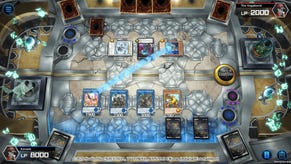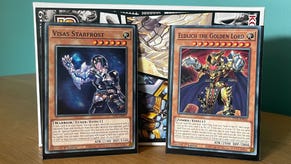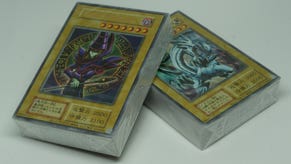Tired of the cost to compete in Yu-Gi-Oh? Play cute, not competitive
Pot of Greed.
As much fun as Yu-Gi-Oh! can be, it’s a difficult game to recommend to newcomers. I genuinely believe anyone who wants to jump into the game should try it out for themselves - and it’s cheaper than ever to do so with games like Yu-Gi-Oh! Master Duel and in-person TCG sealed events offering an inexpensive way to get a hand on cards and play against others.
But what happens when that player wants to jump from casual to competitive play? That’s a difficult and expensive jump to make and one which, for most people, may not be worth it.
At least, depending on your approach. See, in the competitive scene, rising to the top can at times feel like a pay-to-win barrier to entry that’s simply too much of an economic burden for many players. We live in an era where the top decks of the current post-Dimension Force meta are more expensive than a new games console. If you’re someone who feels pressured to play the best cards, that’s an intimidating proposition. Which is why I’m here with a simple plea: play cute, not competitive.
Look, I get it. We all want to be the very best (like no-one ever was). Yu-Gi-Oh! is no different. People want to help out other players, have fun and make friends, and this approach applies whether we’re talking about card games, cricket or anything in-between. But for some a big part of that fun comes from winning, especially in a competitive environment and a game driven exclusively by competition like Yu-Gi-Oh! There’s a satisfaction that comes from refining your strategies and deck for weeks, even months, and having it pay off with the perfect counter that sets you on course for victory.
It’s the natural state of any competitive game. Fighting games may feature dozens of characters and boast an open and varied competitive scene in their early days as players figure out the mechanics, but this changes as knowledge is uncovered and players figure out which characters are strongest. If you play Street Fighter, you’ll see more Cammy and M. Bison than Zangief in top-tier matches, while Super Smash Bros players will likely compete against more Jokers than Jigglypuffs.
Where a card game differs from a fighting game is upfront cost. In Street Fighter, the jump to playing a different, more competitive character is a different menu choice (or at worst, a DLC purchase rarely more than £20) and a few dozen hours of practice - a drop in the bucket for a competitive player at top levels. For those players who choose to gravitate towards these top decks in Yu-Gi-Oh!, the cost of gravitating towards a new competitive deck is incredible luck with sealed packs or, more likely, a jump into the eBay market for several hundreds in new cards. A top-strength Floowandereeze matching the decklist used by Diego Ganzerli to win the Italian Nationals would cost over £600.

Frankly, it’s impossible for many players, particularly younger audiences, to play many of the decks typically considered the ‘best’, even before we talk about ban lists and meta changes meaning those who do take the plunge on a competitive deck may see it decimated within months and need to spend all that money again. Prank Kids players were ascendant in May. Now, many have had to completely scrap their decks and pony up more cash to play a different competitive deck.
It’s an untenable situation for all but the most wealthy or successful players with the ability to endlessly refresh their decks no matter how many times their relevance is diminished.
With this in mind, why bother? Victory, sure, is sweet, but wouldn’t it be even more satisfying if you climbed to the apex using the element of surprise with a deck no-one saw coming? Forgoing the meta can have its advantages, opening the possibility of playing a huge range of decks deemed less competitive by the majority but with the ability to wreak havoc in the hands of the right person. And it saves you money in both the short and long term.
Let me introduce you to Madolche, my go-to competitive deck of the past decade. It may never have reached the dizzying heights of other archetypes in the competitive scene, but when players least expect it, this is the deck that allowed me to hold my own and compete with the best while making victory feel all the sweeter. Literally.
Madolche are a pudding-based archetype based on the structure of the royal family, whose unique gimmick can be found in their ability to shuffle themselves back into the deck when sent to the graveyard to ensure a near-endless recycling of resources. To oversimplify the deck, the aim is to bring out the deck’s boss monsters like Madolche Queen Tiaramisu and Puddingcess Chocolat-a-la-Mode in order to remove opposing monsters from the field of play to create the space for the deck to attack your opponent directly.
Tiaramisu’s ability allows it to shuffle your own Madolche cards from the graveyard to shuffle that same number of cards from your opponent’s field, with additional advantage offered when cards like Madolche Ticket, Salon and Chateau. Therefore, you ideally wish to use cards like Madolche Hootcake, Petingcessoeur and Anjelly to bring the cards to the field needed to summon these monsters as fast as possible.
When effectively executed, it’s easy to wipe out your opponent’s card advantage without allowing them to replenish it themselves since your support cards will allow you to essentially never run out of resources.

As someone looking to get back into the game in 2011, knowing my retro cards from my days of dominating the schoolyard in the 2000s were simply not gonna cut it, I needed a new deck. It was at this time I stumbled upon the deck and, after some experimentation, was drawn to its unique recycling mechanics. To build the deck was relatively cheap, and I spent just over £100 getting together the Extra and Main Deck cards needed to build the deck to full strength and compete in tournaments.
This was the era of Spellbooks, where Spellbook of Judgment’s ability to build incredible advantage had propelled the deck to the forefront of the meta. Those competing in tournaments were either playing the deck or playing decks that could counter its phenomenal success. Madolche at this time were nowhere near as strong as Spellbooks, I can guarantee you of that, but they offered the element of surprise.
This was a rogue deck, and one that opponents would rarely have the cards in their Side or Main deck to effectively counter. With this surprise factor I was able to defeat stronger players and decks due to them lacking the cards necessary to stop me from recycling my monsters and removing their key cards from the field in a non-targeting manner using Tiaramisu. More importantly, I was playing a deck I loved and had built myself (from a basis of online videos), a deck that wasn’t expected to perform well, making every victory that much more satisfying.
For me, this was the deck that finally allowed me to embrace a new era of Yu-Gi-Oh! Progressing from the days when Tribute summoning the almighty Summoned Skull was a game-ending power play to a game ruled by Xyz and Synchro monsters was a culture shock, yet this deck offered an accessible way to engage with this era using cards that took advantage of these powerful mechanics without breaking the bank. It allowed me to learn the ropes without too much upfront investment while still being able to compete.
Whereas playing a meta deck inevitably means needing to replace it when a ban list removes it from its perch, anti-meta and non-meta decks like this stick around and can merely evolve with the times. They never need to be fully replaced, meaning that upgrades and efforts to make them duel-ready are inexpensive over the cost of building a whole new deck.
I’m far more protective of my Madolche deck because of the emotional attachment I have beyond their perceived ability to compete at the top level, and that dedication has been rewarded with occasional rises and falls in competitive viability. Over the years I’ve continued to evolve the deck while refining other styles, always having this deck in my stable as one whose strategies I can memorise and recite while competing using these cards above their perceived ability level.
It’s easy to be drawn to those decks perceived as the best, but you don’t have to feel pressured to spend so much cash in order to compete. Sometimes cute, not competitive, is key to victory, as mastering an archetype you love and the element of surprise can go far if you have the patience to refine your deck around whatever your opponent could potentially play.
In fact, why don’t I get you started. If you wish to find a less expensive deck with the ability to still compete (and be cute while doing so), why not play Madolche! Here’s a deck list of my own with my current build for the archetype that I’d recommend testing out:
- 3x Madolche Anjelly
- 3x Madolche Hootcake
- 3x Madolche Magileine
- 2x Madolche Messengelato
- 3x Madolche Petingcessoeur
- 1x Madolche Puddingcess
- 1x Nibiru, the Primal Being
- 3x Ash Blossom and Joyous Spring
- 2x Called by the Grave
- 3x Forbidden Droplet (Forbidden Chalice or Dark Ruler no More for cheaper substitutes)
- 1x Madolche Chateau
- 3x Madolche Salon
- 1x Madolche Ticket
- 3x Pot of Extravagance
- 3x Gosen Match
- 3x Solemn Strike
- 2x Madolche Promenade
- 3x Madolche Queen Tiaramisu
- 3x Madolche Teacher Glassouffle
- 3x Madolche Puddingcess Chocolat-a-la-Mode
- 2x Divine Arsenal AA-Zeus - Sky Thunder
- 1x Number 41: Bagooska the Terribly Tired Tapir
- 3x Madolche Fresh Sistart










